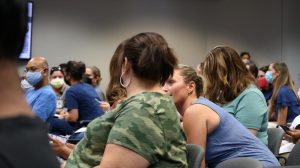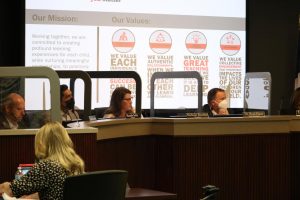Contact tracing ensures effective COVID-19 tracking
The contact tracing process began last school year when some students were virtual and some were in person. If a student tests positive for COVID-19, Coppell High School administrators facilitate this contact tracing process.
September 12, 2021
With the COVID-19 pandemic continuing throughout the beginning of the school year, Coppell ISD continues to monitor COVID cases through the contact tracing process.
“We’re responding as we can to keep our students and staff safe,” CISD executive director of communications and community engagement Angela Brown said. “We had a great system in place [last year] and the system this year is similar. We’re coming to figure out ways we can do [contact tracing] well and effectively.”
Contact tracing is the process of identifying those who have come in contact with an infected person and then collecting information about the contacts. In CISD, the contact tracing process begins with a student testing positive for COVID-19. The parent will then notify the front office of the campus or the nurse, who then will contact an administrator who will talk the family through several questions to begin contact tracing. These questions include asking if the student was tested when the student was tested, what symptoms the student is exhibiting and when these symptoms started.
Associated symptoms, which are the combination of common COVID-19 symptoms, such as a productive cough, fever and feelings of lethargy, are key in this process.
If the student is symptomatic, the administrators begin examining their schedule for close contact from two days before symptoms are shown. Administrators then see who the student was within six feet distance for more than 15 minutes. If both individuals during that period were masked, then the interaction is not considered as a close contact. If one individual was unmasked, then it is considered as a close contact. All classes, extracurriculars and the lunch period are examined.
“Every case is a little bit different,” Brown said. “Sometimes, we can quickly determine who the close contracts might be because [the student] only went to two classes [or] the two previous days was a weekend. Each case is a little bit different so there might be cases when [the process] might take a little bit longer but typically we try and get it done as quickly as we can.”
Students who test positive are required to stay home for at least 10 calendar days after being tested. However, the Texas Education Agency (TEA) allows for parents of close contacts to opt out of the quarantine process. These absences will be excused and the student will have the ability to make up the work once they return.
“You can put some things on Schoology,” CHS EMT and pharmacy tech teacher Gary Beyer said. “[Students] can still do some projects at home, but there are no Zooms like [last year]. [Students] might be able to do some things when [they’re] at home, otherwise, [they’re] going to have to make it up when [they] get back. But that’s been that way forever. It’s [their] responsibility.”
Positive cases are reported on the CISD COVID-19 Dashboard. The dashboard contains data from test-confirmed COVID cases across CISD and self-reported cases from people who became sick at home and did not visit a CISD facility. Virtual student cases from K-6th grade are not reported. The dashboard is manually updated with the number of positive cases at each campus as reported to the campus administrators every day.
“We highly recommend that [contact traced students] stays home and quarantine,” CHS Principal Laura Springer said. “Our job is what CDC tells us to do and [to follow] TEA guidelines. So far, it’s been very successful.”
Follow Akhila (@akhila_gunturu) and @CHSCampusNews on Twitter.














